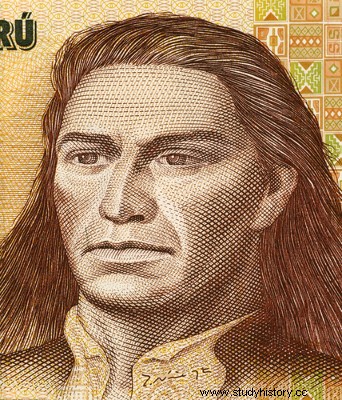
By Me. Cláudio Fernandes
José Gabriel Concorcanqui, better known as Tupac Amaru II , was an important political figure in South America at the end of the 18th century, a time when the Hispanic colonial company was established and he had to face rebellions on the part of the local Indians, who claimed the condition of heirs of the civilization inca e they still tried to resist the structure of colonization.
There were many agreements between the Spaniards and the local Indians. Generally, the local leader, called curaca , was responsible for establishing a contract with the colonizer that guaranteed the supply of labor in exchange for receiving part of the taxes. With this measure, the Spanish colonists did not need to alienate the indigenous population with military confrontation.
However, in 1780, Tupac Amaru II, who was one of these curaca leaders, rebelled against the Spanish colonial structure, declaring himself a direct heir of the Inca leader Tupac Amaru, known by the resistance to the Spanish conquest of that civilization in the 16th century. Tupac Amaru II, or José Gabriel, studied at the Universidad de San Marcos, in the capital of Peru, Lima, and obtained an education permeated by Enlightenment ideas, similar to that of the Minas Gerais intellectuals who participated in the Inconfidência had.
The ideas of freedom and the struggle for equal rights helped Tupac Amaru to project a rebellion against the Spanish metropolis, thus organizing an indigenous insurrection in Peru, also with the support of the elite from creoles (settlers residing there) and of mestizos in that country. Amaru's proposal consisted mainly of disobeying the colony's tax order to the crown.
However, Amaru's organization was later dismantled and its leader cruelly killed by the metropolitan authorities. The researchers Kátia Gerab and Maria A. Campos Resende reported in their book “The rebellion of Tupac Amaru – resistance in 18th century Peru” about the execution of the indigenous leader. In the book, we can read the cruel way in which Tupac Amaru II was killed:
“(...) Four ropes were tied to his hands and feet and tied to the backs of four horses (...). I do not know whether because the horses were not very strong, or the Indian, in fact, was made of iron, they could not at all divide him, after an interminable moment in which they kept pulling him, so that they had him in the air, in a state where it looked like a spider. So much so that the visitor, moved with compassion, so that that unfortunate man would no longer suffer, dispatched an order ordering the executioner to cut off his head, as he was executed (...) In this way, José ended up Gabriel Tupac Amaru and Micaela Bastidas. (...) On this day a large number of people came (to the square), but no one shouted or raised a voice (...). (Kátia Gerab and Maria Angélica Campos Resende. Tupac Amaru's Rebellion - struggle and resistance in 18th century Peru . São Paulo:Editora Brasiliense, 1987. PP. 40 - 41.)
It can be seen that Tupac's death, to be an example to other indigenous people who attempted a similar insurrection, was initially programmed as a torture. The aim was to rip off his arms and legs with the force of four horses. However, as a result of the ill-fated attempt at torture, his head was cut off. All done in a public square, as a macabre spectacle for the local population.
*Image Credits Shutterstock and Gergios Kollidas
